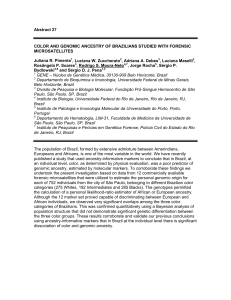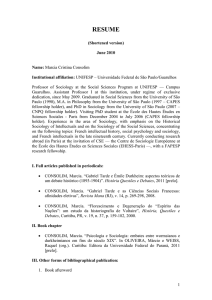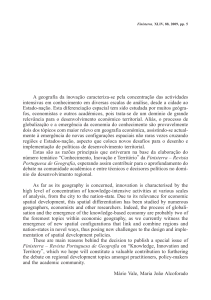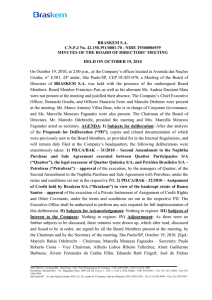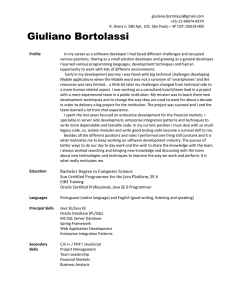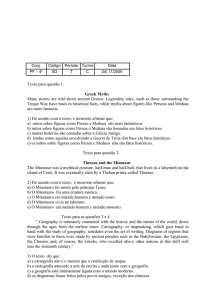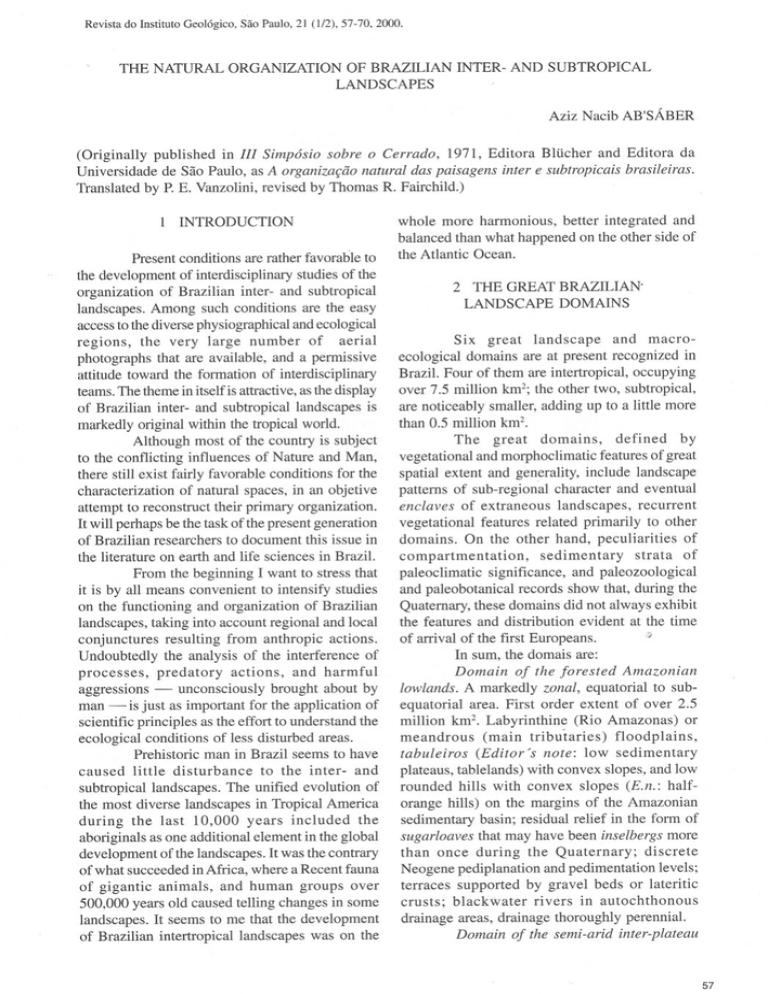
Revista do Instituto Geológico, São Paulo, 21 (1/2), 57-70, 2000.
THE NATURAL ORGAN1ZAT10N OF BRAZ1LIAN 1NTER- AND SUBTROP1CAL
LANDSCAPES
Aziz Nacib AB'SÁBER
(Original1y published in lU Simpósio sobre o Cerrado, 1971, Editora B1ücher and Editora da
Universidade de São Paulo, as A organização natural das paisagens inter e subtropicais brasileiras.
Translated by P. E. Vanzo1ini, revised by Thomas R. Fairchild.)
1 1NTRODUCTION
Present conditions are rather favorable to
the development of interdisciplinary studies of the
organization of Brazilian inter- and subtropical
landscapes. Among such conditions are the easy
access to the diverse physiographical and ecological
regions, the very large number of aerial
photographs that are available, and a perrnissive
attitude toward the formation of interdisciplinary
teams. The theme in itself is attractive, as the display
of Brazilian inter- and subtropical landscapes is
markedly original within the tropical world.
Although most of the country is subject
to the conflicting influences of Nature and Man,
there still exist fairly favorable conditions for the
characterization of natural spaces, in an objetive
attempt to reconstruct their primary organization.
1twill perhaps be the task of the present generation
of Brazilian researchers to document this issue in
the literature on earth and life sciences in Brazil.
From the beginning I want to stress that
it is by alI means convenient to intensify studies
on the functioning and organization of Brazilian
landscapes, taking into account regional and local
conjunctures resulting from anthropic actions.
Undoubtedly the analysis of the interference of
processes,
predatory
actions, and harmful
aggressions - unconsciously brought about by
man - is just as important for the app1ication of
scientific principIes as the effort to understand the
ecological conditions of less disturbed areas.
Prehistoric man in Brazil seems to have
caused little disturbance
to the inter- and
subtropicallandscapes.
The unified evolution of
the most diverse landscapes in Tropical America
during the last 10,000 years included the
aboriginals as one additional element in the global
development of the landscapes. It was the contrary
of what succeeded in Africa, where a Recent fauna
of gigantic animaIs, and human groups over
500,000 years old caused telling changes in some
landscapes. It seems to me that the development
of Brazilian intertropical landscapes was on the
whole more harmonious, better integrated and
balanced than what happened on the other side of
the Atlantic Oceano
2 THE GREAT BRAZ1LIAN'
LANDSCAPE DOMA1NS
Six great landscape
and macroecological domains are at present recognized in
Brazil. Four of them are intertropical, occupying
over 7.5 million km2; the other two, subtropical,
are noticeably smalIer, adding up to a little more
than 0.5 milIion km2•
The great domains,
defined
by
vegetational and morphoclimatic features of great
spatial extent and generality, include landscape
pattems of sub-regional character and eventual
enclaves of extraneous landscapes, recurrent
vegetational features related primarily to other
domains. On the other hand, peculiarities of
compartmentation,
sedimentary
strata of
paleoclimatic significance, and paleozoological
and paleobotanical records show that, during the
Quatemary, these domains did not always exhibit
the features and distribution evident at the time
of arrival of the first Europeans.
"
1n sum, the domais are:
Domain of the forested Amazonian
lowlands. A markedly zonal, equatorial to subequatorial area. First order extent of over 2.5
milIion km2• Labyrinthine (Rio Amazonas) or
meandrous
(main tributaries)
floodplains,
tabuleiros (Editor 's note: low sedimentary
plateaus, tablelands) with convex slopes, and low
rounded hills with convex slopes (E.n.: halforange hills) on the margins of the Amazonian
sedimentary basin; residual relief in the form of
sugarloaves that may have been inselbergs more
than once during the Quaternary;
discrete
Neogene pediplanation and pedimentation levels;
terraces supported by graveI beds or lateritic
crusts; blackwater rivers in autochthonous
drainage areas, drainage thoroughly perennial.
Domain of the semi-arid inter-plateau
57
Revista do Instituto Geológico, São Paulo, 21 (1/2),57-70,2000.
I - AMAZONIAN
o
v - ARAUCARIA
VI - PRAIRIES
VII - TRANSITION
BELTS
SIJ31ROPICAL PLAJEAUS
ARAuc..A.RlA
\A,I1TH
D
AZIZ AB' SABER
(UNDIFFERENTlATW)
1970
Õ1Õ05Ôü
FIGURE 1 - Brazilian morfoclimatic domains (core areas)
depressions of the Northeast. Sub-equatorial and
tropical.Azonal. Second arder extent, 700-850,000 km2•
Inter-plateau depressions reduced to veritable
erosion plains, gi ven the great extent of
pediplanation and the thoroughness ofthe process;
remains of Neogene pediplains ("superficies
sertanejas") reduced in many places to present
erosion plains by Quaternary resumption of
pediplanation; eventual outcrops of fresh rock
within areas ofrock weathered to depths of l-3m;
network of local stony floors; intermittent
drainages,
because of irregular and poorly
distributed rainfall (350-600 mm/year, with strong
year to year unevenness); semi-anastomosed
channels with characteristic, unrnistakable pattem;
notable fields of crystalline inselbergs (Milagres,
Patos, Quixadá).
Domain of the forested "seas of hills"
("mares de morros"). First order spatial extent,
approximately I rnillion km2• Azonal, extending
along the Atlantic facade of Brazil. Extensive
mamelonization
(E.n.: neologism from the
58
Portuguese mamelonização, complex processes
of slope rounding
in crystaline
terranes,
polyconvex slope pattem) on alllevels, Il)asking
planed summit or intermontane surfaces: levels
of pedimentation
or even terrace levels.
Polyconvex slopes (LIBAULT, 1971), with
maximum degree of mamelonization; weathering
and mamelonization
are more evident on
intermontane
levels, wbich leads to the
supposition of an alternation of sedimentation and
mamelonization;
meandrous
plains
and
predominance
of fine sediments in alluvial
channels; superimposed
soils, which means
colluvial deposits burying stone !ines; remarkable
sugarloaf fields; rainfall 1000-4500 mm/year;
tropical forest originally covering 95 % of the area.
Enclaves of araucaria on high places, of cerrados
in several low compartments
of the inland
plateaus, where forested chapadões predominate
(seas ofhills) (E.n.: chapadões are high plains with
complex structure or table-like rolling pJateaus).
Domain ofthe "chapadões" covered by
Revista do Instituto Geológico, São Paulo, 21 (112), 57-70, 2000.
cerrados and penetrated by gallery forest. First
order spatial extent, 1.8-2-million km2. Roughly
zonal, like the savanna belts of Africa. Massive
complex plateaus and compartmented sedimentary
plateaus, cerrados and cerradões on the interfluves;
continuous gallery forest, of varying width;
headwaters
in dales, i.e., small swampy
amphitheatres; soils in general with low primary
fertility; both primary and secondary elements of
the drainage perennial, waterways on slopes and
interfluves intermittent; very broad interfluves and
widely or spaced valleys; little branching of the
drainage in the core area; forest enc1aves on better
soils and around springs; no mamelonization;
particular types of fluvial channels, generally nonmeandrous on the plateaus; levels of pediplanation
on plateau compartments, step-like pediments and
terraces with gravels; indications of c1imatic and
landscape fluctuations in the central and peripheral
intermontane depressions; c1imate of Sudanese
type, rainfall 1300-1800 mm/year, concentrated
in the summer, relatively low in winter. Forest
enc1aves (capões) of varying area.
Domain of the araucaria plateau.
Approximately 400,000 km2 in area; subtropical
humid climates with mild winters. Medium altitude
plateaus, 800-1300 m high, covered with araucaria
forests of diverse density, including mosaics of
mixed prairies and small araucaria woods ~ in
galleries, on hillslopes or around headwaters. Depth
of weathering very variable, with imperfectly
convex hills except in the gneissic area around the
Curitiba basin. Eventual colluvia on slopes,
covering subrecent topography,
with large
microrelief irregularities, corresponding to a drier
climate (e.g. the plateau south of Lajes and north
of Vacaria). The araucaria cover is denser on the
basaltic plateaus of medium relief. lslands of
grassland, mixed high prairies, in areas of
occasional sandstone outcrops (Lajes, Ponta Grossa,
Purunã Plateau). More than by its intrinsic relief,
this domain is characterized by great pedological
differences in comparison to the other Brazilian
intertropical plateaus. Additionally, the "aging" of
Atlantic polar air masses in the area lowers the
temperature throughout this region (states ofParaná,
Santa Catarina and northeastem Rio Grande do Sul).
Drainage is perennial and rainfall rather evenly
distributed throughout the year. The higher areas
(Plateau of São Joaquim, Lajes, Curitibanos) are
subject to eventual snowfalls.
Domain of the mixed prairies
of
southeastern Rio Grande do Sul. Approximate area
80,000 km2, comprising a sort of border for the
domain of the Pampas prairies while epitomizing a
more or less individualized landscape pattem of
the Uruguayan-Argentinian prairies. A landscape
of temperate humid and sub-humid areas, subject
to summer droughts, with a rather original
landscape ensemble: it is a domain of pluriconvex
hills, inc1uding grassland on gentle slopes and
gallery forest along alluvial channels. The soils
differ from everything that is known from tropical
Atlantic Brazil, inc1uding pattems peculiar to the
margins of the prairie domain. Drainage is perennial
and predominantly meandrous, with small volume
and low regional density. The domain pccupies
sedimentary terrains of diverse age, as well as
basaltic areas, and makes inroads into crystalline
areas of the Uruguay-Rio Grande do Sul plateau,
commonly known as the "Serras de Sudeste".
3 THE BELTS OF TRANSITION AND
CONTACT BETWEEN THE GREAT
BRAZILIAN LANDSCAPE DOMAINS
From my travels along itineraries
meaningful to the understanding
of natural
landscapes, I early understood that linear borders
cannot be drawn between the great morphological
and ecological domains . A preliminary attempt at
charting the core areas demonstrated the existence
of a complex network of transition and contact belts
- in places narrow, in places broad and complexo
From the outset, it was evident that hidden within
the transition and contact corridors was a large
number of combinations
of heterogeneous
physiographic facts. ln reality, every sector'Df these
elongate belts represents a peculiar regional
combination of ecological and physiographical
events, that may occur again in neighboring areas
yet which is almost never repeated at a distance. It
was easy to suppose that between domains A and
B there would occur transitibns or contacts of type
A+B. It was noticed, however, that there are belts
which occupy broad irregular bands between
domains A, B and C, with a remarkable increase in
the number of combinations through mosaic
contacts, with local subtransitions. Field research
in several key areas (especially Maranhão and
Bahia) revealed that, besides areas of complex
contact among three or more contiguous domains,
there are vegetation buffers along certain segments
of these so-called transitional belts. Thus nuc1ei of
vegetation may appear without direct connection
with A, B or C. These are floras that have taken
59
Revista do Instituto Geológico, São Paulo, 21 (1/2),57-70,2000.
advantage of the instability of the belts and
dominated ecological spaces locally unfavourable
to elements of the contiguous domains (A, B and
C, or B, C and D, or even A, C and F), but
favourable to certain specific floras, cocais (palm
forests) and matas de cipó (vine forests).
No detailed research has been carried out
yet in these belts. My own itineraries have rather
been transects, but they perrnit me to present basic
models ofthe natural organization ofthe transition
and contact belts, of course of a very preliminary
character.
1. Transition belts due to topographical and
topoclimatic compartmentation
(Central
Bahia).
2. Complex belts (agreste type), in areas of
sharp climatic fluctuations between subhumid and moderately sub-arid climates.
3. Transition
due to sharp changes of
topographical
and pedological features
(sublittoral zones of Sergipe and Paraíba).
4. Belts with subnuclei of buffer vegetation
(palm forests of Maranhão, vine forests of
Bahia).
5. Mosaic belts, controlled by soils, paleosols
and inheritance of topographical position
(plateau of Franca and northeastern São
Paulo).
6. Transition between cerrados and dry forests,
separated by broad belts of gallery forest
(pre-Amazonian Maranhão, Pontal area of
São Paulo).
7. Belts with mixtures of floras, or with orderly
or semi-orderly coalescence of vegetation
types (Pantanal of Mato Grosso, Paranaguá
Plateau, Island of Marajó).
8. Belts of the inter- and subtropical littoral
zones, with interference of marine, eolian,
lacustrine and fluvial processes (littoral of
Amapá, Lençóis Maranhenses, coast of Rio
Grande do Norte, sandstone reef coasts,
littoral of Sergipe and Bahia, Cabo FrioMacaé in Rio de Janeiro, Cananéia-Iguape
in São Paulo, coastal plain and lagoons in
Rio Grande do Sul).
Each of these regional
models is
characterized by a subtle combination of easy-tounderstand physiographical and ecological facts.
It is harder, however, to carry out more detailed
studies aimed at analyzing and appraising the
elements that combine to give rise to the
subregional landscape complexes. Such studies
60
will demand multidisciplinary
determined effort of complex
cartography.
teams and a
physiographic
4 THE EVOLUTION OF FLORAS
FROM THE CRETACEOUS TO THE
QUATERNARY IN BRAZIL
I plead that it be permitted to a nonspecialist attempt to assemble the fragmentary
documentation on the plant cover of Brazil since
the Cretaceous; it is anyway mostly indirect
evidence. I here add some new information to a
previous review (AB'SÁBER, 1951) 'aimed at
geomorphologists.
In my opinion a fundamental starting
point is the presence of caliches and similar deposits
in the Bauru Group and other Cretaceous
forrnations. The Early Cretaceous was a time of
large deserts (the Botucatu Desert); from then on
there was an attenuation ofthe aridity. Judging from
the contemporary sediments, a large part of the
country had hot semi-arid and semi-humid climates,
the general landscape being one of large shallow
lakes fIlling inland detritic depressions, surrounded
by semi-desertic areas of sub-continental size.
The presence
of caliches in such
disparate
areas as the Triângulo
Mineiro
(southwestemmost Minas Gerais), Rubião Junior,
São Paulo, and the northeastem chapadas (Apodí,
Araripe), where lacustrine limestones occur,
points to soils of pedocal type, formed under
harsh, semi-arid conditions. At that time, the
vegetation would have been of a sub-desertic type,
in agreement with the soil types - in any case a
type of vegetation very different from any
presently known.
The post-Cretaceous
uplift of the
Brazilian plateau, and the attendant phenomena
of circumdenudation that compartrnented the great
block extending from Rio Grande do Sul to the
border of the Amazon basin, resulted in different
landscapes, under climates much moister than the
Cretaceous ones, and with exorheic drainages,
frankly open to the sea. This new topography,
more compartmented and with soils produced by
moister climates, lasted for long periods of the
Tertiary. I believe that from the Mid- Tertiary on,
the prevailing soils were pedalfers. This was, in
fact, the great global change in the evolution of
the plateaus and inland landscapes of Brazil
betweeen the Late Cretaceous and the Tertiary.
In the assembly of evidence about this
Revista do Instituto Geológico, São Paulo, 21 (1/2),57-70,2000.
strong ecological change, a distinctive part refers to
small detritic basins in compartments of the Brazilian
plateau, where certain types of sediments were
preserved. During the Tertiary epeirogenic uplift,
there was an extraordinary evacuation of detrital
materials through the open drainage toward the River
Plate and the continental platform, few inland
sedimentation areas remaining free from erosion.
Such are the basins ofTaubaté, São Paulo, Curitiba,
Rezende, Volta Redonda, Atibaia, Fonseca and
Gandarela, as well as some isolated coastal basins
in the northeast and in the south of the country
(Ribeira, Alexandra, Pelotas). In the Northeast and
in Amazonia there remain important detrital masses
dating from the late Tertiary or the early Quatemary.
The presence ofhuge clay strata in these beds shows
that, before they were deposited, the area had soils
resulting from chemical weathering in humid
conditions, witl1 tl1ick regolitl1s, especially on
crystalline rocks. Without this prior formation of
clays, there would have been no matrix for the fine
sediments of the basins. In fact, the removal of the
altered clay beds would have been possible only
during an aggressive phase of areolar erosion,
concomitantIy with eventual tectonic damming of
certain plateau compartments, or with a new phase
of basin formation, as in Amazonia.
There must have been a steady and
intensive fIow of fine sediments toward the
River Plate and the continental platform, the
only exceptions
been those carried to the
Amazon Basin, and those originating in the
intermontane compartments of the Northeast
and carried to the band now occupied by the
detritic Barreiras
Group. Identically,
the
sediments that remained nested in a few, but
highly significant, plateau compartments
of
southeastern Brazil, document the aIternation
of humid and dry climates, with a general
predominance of pedalfer soils.
It is important to note, based on such
facts, that all the vegetation stocks closely related
to the present inter- and subtropical vegetation
(forests, cerrados, caatingas, araucaria and
prairies) were elaborated after the Mid- Tertiary.
During the Quatemary, such floras fluctuated in
space, controlled by successive climatic changes,
consequent upon the unstable climatology of the
period.
There are suspicions that in some areas
there may have been steppes or grasslands only
slightly different from present ones. There is
reason to believe, however, that the basic stocks
were already shaped by the end of the Tertiary
and persisted throughout the Quaternary in
diversified and complex spatial arrangements. It
is not yet possible, however, to map securely the
evolution ofthe vegetation during these times; the
information is still toa fragmentary.
5 MAMELONIZATION VS
PEDIMENTATION IN THE EVOLUTION OF
THE RELIEF OF ATLANTIC TROPICAL
BRAZIL
Regional geomorphological research and
studies of the changes of pace in the physiology
of the landscape consequent upon Quaternary
climatic fluctuations have clarified many questions
related to the expansion and retreat of forests in
Atlantic tropical Brazil.
André Cailleux and Jean TRICART (1957),
based on evidence from Quaternary deposits and
other geomorphological features, first established
that intensive fIuctuations between humid and
dry climates occurred in Atlantic tropical Brazil
during the Quaternary. On the other hand, the
Northeast would have had more stable semi-arid
climates, similar to the present one (TRICART 1958).
I used to think differently (AB'SÁBER 1956) but
now partially agree with Tricart. As for Central
Brazil, I think that climatic fIuctuations were
more pronounced in the interplateau depressions
that surrounded
or penetrated
the regional
chapadões. The cerrado landscape should have
been more or less stable in the higher areas, the
changing climates (Sudanese-type)
affecting
instead regions such as the depression between
the Espigão Mestre (E.n.: plateaus of northwest
Minas Gerais and west Bahia) and the Brasilia
Plateau, or the interplateau depressions of the
Upper Araguaia and the Paraná Basin.
In the present work shall confme myself
to the question that I consider fundamental to the
knowledge of paleoclimatic and paleoecologic
fluctuations in the eastem and southeastem Atlantic
facade ofBrazil, i.e.,the altemation of drier andmoister
climates and its phytogeographic implications.
In southeastern Brazil, as shown by
several authors, there is a topography, regional in
expression, constituted by an endless succession
of rounded slopes (DEFFONTAINES 1959). It is the
domain of the seas of hills , in my latest conception
of this area from the viewpoint of regional
morphoclimatic characterization (AB'SÁBER 1963,
I
61
Revista do Instituto Geológico, São Paulo, 21 (1/2),57-70,2000.
1966). The individual features have been calIed
half oranges, turtle shells, rumps, elephant-back
hills, round hills, mamelões (E.n.: rounded breastlike hilIs) and other terms related to their visual
appearance. TechnicalIy, in terms of geometric
characterization, they would be polyconvex slopes
(LIBAULT 1971).
Geomorphological studies performed in
southeastern Brazil, the core area of the seas of
hills domain, have shown that, paralIel to the
development of rounded, predominantly gneissic
and granite-gneissic
slopes, there occurred a
dissemination of humid tropical pedogenetic
processes and a spread, via coalescence, of forests
over mamelonizated
slopes and the uneven
interfluves of mountainous areas.
The word mamelonization is here used
in the sense of an ensemble of physiographical
processes sufficient to round off slopes of
weathered crystalIine rocks into polyconvex
shapes, in paralIel with the deepening of chemical
weathering and the dendritification of the minor
branches of the drainage. It is in fact a system of
integrated evolution of the landscape, rapidly
elaborated and long-Iasting in the absence of
intervening climatic changes toward savanna or
even drier climates.
Pedimentation is here used in the sense
of a process of restrictive lateral planation,
occurring
predominantly
on piedmont
or
intermontane
areas, under the influence of
subtropical climatic fluctuations. It should be
noted that these pedimentation processes occur in
subtropical and even in extra-tropical areas, by
convergence. Here I shalI deal with pedimentation
within the southeastern Brazil modelo
Intertropical
pedimentation
and
mamelonization are opposing processes. In areas
subject
to mamelonization,
with deeply
decomposed rocks stabilized by the protection of
tropical forests, only radical, sharp climatic
changes can launch aggressive
phases of
generalized erosion, at the end of which the region
will have suffered limited lateral planation by
pedimentation. It is a process of formation of
erosional ramps, lateral to the axes of intermontane
depressions, where semi-aridity may have set in
early, or, stilI, of this same type of ramp at the foot
of scarps or mountains whose lower slopes face
semi-arid littoral or sublittoral belts. At any rate,
pedimentation wilI only occur by removal of the
regolith of the rounded hilIs in specific topographic
situations, involving the presence of low hills
62
embedded in higher relief, or asymmetric areas at
the foot ofhumid tropical scarps. Such conditions
were present during the whole Quaternary in the
middle valIey of the Paraíba, on almost alI tropical
scarps of Atlantic Brazil, and in many other
intermontane and interplateau compartments of
inner Brazil.
Geomorphological observations made
during the last 25 years permit me to assert that
intertropical pedimentation can only occur in its
fulIness during the transition from a phase of
landscape shaping by mamelonization to a phase
of aggressive regional erosion, yet only when
restricted
to intermontane
or piedmont
compartments.
Pedimentation ramps would result from
sharp changes in the physiology of the landscape.
After a long phase of mamelonization
under
general forest cover, the change to a drier climate
would result in aggressive erosion of the hills with
initial loss of forest cover and the ensuing
appearance of multiple ravines, widespread
removal of polyconvex slopes in the intermontane
compartments, and transport of detrital materiaIs
away from the main area of pedimentation. This
description is enough to characterize the process
of mamelonization in the terminology ERHART
(1955) as typical of biostasy, occurring in humid
phases, and pedimentation, taking place during a
phase of instability and change, as a typical
processes of rhexistasy.
During periods of mamelonization,
tropical forests reached their maximum extent, by
coalescence of refuges and by an "oil stain" type
of spread. On the contrary, pedimentatioJ;l phases,
corresponding to dry intermontane and/or littoral
climates, were phases of retraction of the plant
cover into isolated remains, such as the present
"brejos" of northeastern Brazil, isolated areas of
humidity located on slopes, mountain tops,
foothills, along creeks, 'and around springs.
Consequently, and given the regional network of
clearly compartmented semi-aridity, this is the
phase that prepares the landscape for the
penetration of semi-arid vegetation into the drier
sectors of the pedimented and pediplaned areas
(inner
interplateau
and
intermontane
compartments) and/or semi-arid coastal areas.
6 THE FINAL STAGES OF
MAMELONIZATION
It is possible to say that the
Revista do lnstituto Geológico, São Paulo, 21 (1/2),57-70,2000.
present polyconvex
slopes are the result of
intensive
chemical
and biogenic
activity
antecedent to the formation of the paleopavements.
A long period of chemical weathering, tropical
pedogenesis and polyconvex shaping was in a
certain moment interrupted by a sporadic dry
phase, which caused partial retraction of the forest
cover and the appearance of slopes with stony
soils, upon which there must have existed a
landscape of caatingas or sparse cerrados (more
probably the former) . When the critical period of
the phase of geologically short duration was over,
the interrupted process was resumed: chemical
weathering,
tropical pedogenesis,
return of
unbroken
forest cover and strong colluvial
activity, as evidenced by the deposits that overlie
the stone lines.
It is impartant to note that the last
sporadic dry episode of the Quaternary (the stone
tine phase) produced a laminar stripping of soils,
resulting in detritic pavements of diversified
structure and thickness. There was not enough
time, however, for a new phase of pedimentation,
such as had repeatedly occurred in the Pleistocene.
On the contrary, resumption of mechanical
morphogenesis in an environment of scrubby and
sparse vegetation permitted only the formation of
discontinuous
stony soils, some made up of
fragments of quartz dykes, others enriched with
Quaternary river gravels reworked and spread out
as detritic pavements (AB'SÁBER 1962, 1969).
One is led to believe that during this
sporadic,
relatively
modern dry episode
ar even
(Pleistocene-Holocene
boundary,
Holocene or sub-recent), retraction of the forest
was discontinuous and incomplete. Otherwise it
was in most places a short phase, since there was
a return to humid tropical conditions with
progressive emphasis on colluviation, parallel to
the reactivation of chemical weathering, sufficient
to bury the stony soils. The forests could then leave
their sizable refuges, and advance over colluvial
soils, helping the maturation of pedogenetic
processes and contributing to the reconstruction
of the humid tropicallandscape.
The buried stone lines remained as
witnesses of this last dry phase that affected areas
of southeastern
Brazil that are nowadays
extensively humid. This perception is due to
CAILLEUX & TRICART (1957). I wish to
underline that the most recent stone lines coincide
with the coarser fluvial deposits on basal or
intermediate levels of the floodplains, especially
in the case of middle- and small-sized rivers. The
large floodplairrs, such as those of the Tietê and
Pinheiros, or middle Parmba, may contain older
deposits in their lower levels of the alluvial
sequence,
going back perhaps to the Late
Pleistocene.
Knowledge of the superficial structure of
the landscape of the domain of the seas of hills in
southeastern Brazil is relevant to geotechnical and
conservation matters. It is intuitive that widespread
removal of the forest, and the subjection of the
landscape to an uncontrollable predatory process
will result in an immediate disequilibrium, with
unpredictable consequences. A sort of anthropic
rhexistasy (AB'SÁBER 1965) is created. The
originator of the biorhexistasy theory (ERHART,
1955) introduced the idea that the main rhexistasy
would be anthropic; I cannot agree. There is,
however, a certain rhexistasy associated with
anthropic action, and the domain of the seas of hills,
especially along the Middle Paraíba, constitutes the
most striking example of such a disequilibrium
(AB'SÁBER 1965). The stone lines buried under
cover deposits are the only elements capable of
maintaining a consistent superficial structure and a
relative equilibrium in a landscape modified by
mano Any injury reaching below the irregular
horizon of the stone lines may result in the savage,
and eventually multiple gullying (boçorocas).
A word to prehistorians: in the case of a
country with a relatively recent prehistoric
population,
it is indispensable
to know the
reference planes in the stratigraphy of the Upper
Quaternary. It is always necessary to refer finds
to the cover deposits and to the stone lines. It seems
that the cover deposits, as well as the basal deposits
of some floodplains, are the only ones that played
a role as correlative deposits of the possible
landscapes occupied by prehistoric man in Brazil.
It is even possible to say that most groups of
primitive
Brazilians
lived and moved in
landscapes posterior to the last dry episode.
However, based on some datings, of modern
sediments and of archeological industry, it is
possible to infer that some archaic groups may
have lived at the time of the stone lines ar of some
pene-contemporary
sand banks or sandbodies.
Except in the case of burials cutting through the
stone lines, it will be possible to date relatively
any artifactual or skeletal materiaIs found among
the stone line gravels or rock fragments; the age
will be a few thousand years. Of course, only
radiometric dating will afford more precise data.
63
Revista do Instituto Geológico, São Paulo, 21 (1/2),57-70,2000.
7
FINAL CONSIDERATIONS
From the study of the great landscape
domains in the country, it is possible to establish
a series of conc1usions relative to the natural
organization of spaces in Brazil. Even better, it is
possible to obtain a better understanding of the
spatial distribution of regional landscape pattems
and models both in core areas as well as in the
transition and contact belts.
One soon perceives that the landscape
mosaic is markedly original when compared with
other sectors of the intertropical belt on Earth. All
domains possess significantly
homogeneous
polygonal core areas. On the contrary, the
anastomosed belts that surround the cores are
discontinuous, showing diversified physiographic
variations and combinations in accordance with
their positioning between two or three domains.
It is therefore difficult to recognize pattems within
these belts, making it necessary to establish
models of relative validity.
In the interior of the core areas there are
regional landscape pattems always related to a
same family of regional ecological environments.
While the intertropical
domains have areas
between 750,000 (semi-arid domain) and 3
million km2 (forested lowlands of Amazonia),
patterns within the cores vary in area, due to
peculiarities of topography, lithology, sub-regional
climates, and soils; they may measure from a few
thousand to hundreds of thousands of square
kilometers. In all cases the differences are subtle,
visible only to capable specialists.
Besides these moderate differences in
landscape pattems, there is stronger cause for
contrasts within the cores: the apparently
anomalous landscapes of the enclaves. These are
practically always small, measuring from a few
hundred to a few thousand sq km. In spite of their
small aggregate area, at most 5% ofthe total area
of each domain, they significantly enrich the
landscape.
The magnitude of the landscape pattems
in each domain is not uncommonly of subregional
In contrast, enclaves are more
dimensions.
restricted in size, usually comprising small
regional landscapes of a few hundred (or less) to
several thousand square kilometers.
Another leveI of variation concems the
physiographic variations and combinations of the
transition and contact belts. These do not show
polygonal
64
arrangement
like that of the cores.
Furthermore, although simplified cartography
may suggest that they are broad corridors, each
sector of each arm of these elongated belts
presents a peculiar, almost exclusive combination
of physiographic facts. Since it is not feasible to
characterize all the features of the transition and
contact belts, we shall describe some of the
principal models.
They show alternation, interference,
mixture or fusion of schemes belonging to more
than one neighboring domain. They may include
some landscapes proper to the domains, mixed
with transitional ones: this is what I call buffer
landscapes. One additional model is a sub-belt or
sub-polygon, in which an individualized botanical
landscape can establish itself, different from
everything that exists in the cores (palm forests,
vine forest).
It should be remembered that the total
richness of the inter- and subtropicallandscapes
of Brazil is a consequence of these structures we
have just considered. Subtle variations, of little
spatial import, are evidenced by regional patterns
of landscapes of each domain. Strong contrasts
occur inside the cores due to the presence of
enclaves; extraordinary and frequent variations,
due to the combination
of interfering
physiographic factors, characterize the transition
and contact belts. The sum constitutes a much
richer conjuncture than it was possible to guess a
few years ago.
Since the present landscapes are the
heritage of a complex and continuous evolution
related to Quaternary
vicissitudes
of the
intertropical world, it is indispensable to eSJablish
the position of such landscape schemes in the face
ofbiostasic or rhexistasic conditions. I believe that
almost all Brazilian landscapes pertain to biostasic
conditions, even, at least in part, the natural
landscapes of the semi-arid Northeast. It is also
certain that Man, irregularly
but in places
extensively, brought about scattered effects of
anthropic rhexistasy. It is indispensable to try to
understand that the present picture represents a
scheme elaborated during a biostasic phase,
starting from the very different landscapes of the
dry phases of the Quatemary. I believe that at
certain times there was widespread semi-aridity,
in the style of present northeastem landscapes,
albeit under probably more active rhexistasic
dynamics. Such a penetration of semi-aridity
throughout the intermontane
compartments
resulted in several resumptions of pedimentation.
Revista do Instituto Geológico, São Paulo, 2] (1/2),57-70,2000.
Again, each phase of pediment
formation
alternated
with epochs of much or little
mamelonization of the topography and chemical
weathering of the rocks.
Coastal regions, littoral or sub-littoral,
were subject not only to marginal epeirogenesis
of the Brazilian Plateau, fault tectonics and
continental flexure, but also to another set of
variations, associated with the intrusion, from
south to north, of a tongue of dry climates along
the Atlantic facade. I believe that in times of low
mean sea leveI (due to glacio-eustatic control) the
cold currents of the southwestem Atlantic reached
farther north than they do now on the coast
Grande do Sul, possibly causing upwelling
present Cabo Frio type north of Espirito
This would cause extensive aridity and
winters.
-
rizonte subsuperficial
de cascalhos
inhumados do Brasil Oriental. Curitiba:
Instituto de Geologia da Universidade do
Paraná, 31p. (Boletim da Universidade do
Paraná, Geografia Física, 2).
-
1963. Contribuição à geomorfofogia da área
dos cerrados. In: Simpósio sobre o Cerrado, São Paulo, Editora da USP, p. 117-124.
-
1965. Da participação das depressões periféricas e superfícies
aplainadas
na
compartímentação do Planalto Brasileiro.
Faculdade de Filosofia Ciências é Letras,
Universidade de São Paulo, São Paulo,
Tese de Livre-Docência.
-
1966a. O domínio morfoclimático dos mares
de morros no Brasil. São Paulo: Instituto
of Rio
of the
Santo.
cooler
The summation ofthe semi-aridity ofthe
northeastem intermontane type with that resulting
from the coastal intrusion from the south created
conditions for the prevalence of semi-arid, and
perhaps partially sub-humid climates, in large
areas of Brazil. There was also, and it is important
to note, a zonation of the dry climates, and
resultant reduced presence of alllandscape stocks
presently known in the country. It is thought that
the dry-epoch landscapes had azonal schemes or,
at least, that most of them had little zonal
expression. However, conditions do not yet exist
to attempt a valid cartography of any of the
predominantly dry phases of the Quatemary. I
prefer to characterize the two great models of
penetration vs relative generalization
of dry
climates, rather than present even a tentative map
of the mosaic of environments and landscapes of
Geomorfológica, 2 (4): 48-49.
1962. Revisão dos conhecimentos sobre o ho-
-
de Geografia, Universidade de São Paulo,
9 p. (Geomorfologia, 2).
1966b. O domínio morfoclimático amazônico. São Paulo: Instituto de Geografia, Universidade
de
São
Paulo,
11p.
(Geomorfologia, 1).
-1967a.
-
1967b. Domínios morfoclímáticos e províncias fitogéográficas do Brasil. Orientação,
(3): 45-48.
-
1968. As boçorocas de Franca. Revista da
Faculdade de Filosofia de Franca 1 (2): 521.
-
1969a. O Quatemário na Bacia de Taubaté:
estado atual dos conhecimentos. São Pau-
'7
our country during any specific dry phase.
lo: Instituto de Geografia, Universidade de
São Paulo, 22 p. (Geomorfologia, 7).
8 BIBLIOGRAPHY
-1969b.
I - Specific works
AB'SÁBER, A.N. 1951. Sucessão de quadros
paleogeográficos no Brasil, do Triássico ao
Quatemárío. Anuário da Faculdade de Filosofia Sedes Sapientiae, São Paulo: Universidade Católica de São Paulo, 1950-51,
p.61-69.
-
1958. Conhecimentos sobre as flutuaçães climáticas do Quatemário no Brasil. Notícia
Geomorfológica, 1(1): 24-30.
-1959.
Pavimentos detríticos atuais e subatuais
das
caatingas
brasileiras
Problemas geomorfológicos da Amazônia Brasileira. Simpósio sobre a Biota
Amazônica, Atas (Geociências), 1: 35-67.
. Notícia
O Quatemárío na Bacia de São Paulo:
estado atual dos conhecimentos. São Pau-
lo: Instituto de Geografia, Universidade de
São Paulo, 15 p. (Geomorfologia, 8).
----- 1969c. Pedimentos
e bacias detríticas
pleistocênicas em São Paulo. São Paulo:
Instituto de Geografia, Universidade de
São Paulo, 12 p. (Geomorfologia, 9).
-
-
1969d. Uma revisão do Quatemário Paulista:
do presente para o passado. Revista Brasileira de Geografia, 31(4): 1-33.
1970a. As ilhas de cerrados das bacias de
Taubaté, São Paulo e Atibaia. São Paulo:
65
Revista do Instituto Geológico, São Paulo, 21 (1/2),57-70,2000.
Instituto de Geografia, Universidade de São
Paulo, p. 20-24 (Cadernos de Ciências da
Terra, 6).
-
1970b. O mosaico primário de matas e cerrados do Planalto Paulistano.São Paulo: Instituto de Geografia, Universidade de São
Paulo, p. 24-29 (Cadernos de Ciências da
Terra, 6).
-
1970c. Os lajedos da Serra de São Francisco:
um exemplo de aridez rochosa no Estado
de São Paulo. São Paulo: Instituto de Ge-
Brasileira de Ciencias, 38: 38-57
BIGARELLA, U. 1964. Variações climáticas no
Quaternário e suas implicações no revestimento florístico
do Paraná. Boletim
Paranaense de Geografia (10/15): 211-232.
-
cias, 37 (Suplemento): 263-278.
-;
ANDRADE, G.O. 1965. Contribution to the
study of the Brazilian Quaternary. In:
International Studies on the Quaternary.
Geological Society of America, Special
Paper (84): 433-451.
.
-;
MOUSINHO, M.R. 1965a. Considerações a
respeito dos terraços fluviais, rampas de
colúvio e várzeas. Boletim Paranaense de
-;
-
ografia, Universidade de São Paulo, p. 2932 (Cadernos de Ciências da Terra, 6).
1970d. Províncias geológicas e domínios
morfoclimáticos no Brasil. São Paulo: Instituto de Geografia, Universidade de São
Paulo, 26 p. (Geomorfologia, 20).
ANDRADE, G. O. 1958 - O relevo da zona pioneira do Espírito Santo e da Região Contestada. Recife: Diretório Acadêmico da
Faculdade de Filosofia, Universidade do
Recife, Coleção Filosofia, Ciências e Letras (3).
-
1964. Armazenamento d'água em pedimentos
detríticos. Arquivos do Instituto de Ciências da Terra, 2: 37-42.
-;
BIGARELLA, U. 1964. Considerações sobre a estratigrafia e sedimentologia do Grupo Barreiras, Região de Recife. In: AGB,
ASSEMBLÉIA GERAL, 19, Poços de
Caldas.
-----; -----; UNS, R.C.1963. Contribuição
à
Geomorfologia e Paleoclimatologia do Rio
Grande do Sul e do Uruguai. Boletim
Paranaense de Geografia, (8/9): 123-131.
UNS,
R.C.
1963
Introdução
à
morfoclimatologia do Nordeste do Brasil.
In: SBG, CONGRESSO BRASILEIRO DE
GEOLOGIA, 17, Recife.
AZEVEDO, L.G. 1963. Tipos de vegetação do Sul
de Minas e Campos da Mantiqueira (Brasil). Anais Academia Brasileira de Ciências, 34 (2): 225-254.
-
-
66
1965. Contribuição à delimitação dos tipos
de vegetação do Estado de Sao Paulo. Região de Campos do Jordão. Arquivos de
Botânica do Estado de São Paulo, 4 (1):
11-21.
1966. Tipos Eco-físionômicos da Vegetação
da Região de Januário. Anais Academia
1965. Subsídios para o estudo das variações
do nível oceânico no Quaternário Brasileiro. Anais da Academia Brasileira de Ciên-
Geografia, (16/17): 153-198.
1965b. Contribuição ao estudo da Formação Pariquera-Açu (Estado de São Paulo). Boletim Paranaense de Geografia, (16/
17): 17-41.
SILVA, lX. 1965a. Considerações a respeito da evolução das vertentes. Boletim
Paranaense de Geografia, (16/17):85-116.
-;
-;-
1965b. Pediplanos, pedimentos e seus
depósitos correlativos no Brasil. Boletim
Paranaense de Geografia, (16/17): 117-152.
-;
-;-
1965c. - Processes and environments
of the Brazilian Quaternary. Prepared for
the VII INQUA CONGRESS, Fairbanks,
Alaska, Imprensa Universitária do Paraná,
Curitiba, 69 p.
/
-;
')
SALAMUNI, R.; AB'SABER, AN. 1961.
Origem e ambiente de deposiçío de Bacia
de Curítiba. Boletim Paranaense de Geografia, (4/5): 71-81.
BENNEMA, J.; CAMARGO, M.; WRIGHT,
A.C.S. 1962.
Regional contrast in
South American soíl forrnation, in relation
to soil classification and soil fertility. In:
INTERNATIONAL
SOIL
CONFERENCE, New Zelando
BIROT, P. 1957. Esquisse morphologique de Ia
région litorale de l'État de Río de Janeiro.
Annales de Géographie, (353): 80-91.
BRANNER, J. C. 1911. Aggraded limestone plains
of the interior of Bahia and clímatic changes
suggested by them. - Geological Society
of America Bulletin, 22: 187-206.
Revista do Instituto Geológico, São Paulo, 21 (1/2),57-70,2000.
giões morfoclimáticas brasileiras. In: Elementos de Geomorfologia Climática, Curso de Férias para Professores, C.N.G.IBGE, Rio de Janeiro, p. 72.
CAILLEUX, A. 1957. Observations sur Ia ligne
de cailloux à Ia base des sols jaunes.
Zeitschrift für Geomorphologie, 1: 312.
-1966.
Os depósitos detritícos, a linha de cascalhos enterrados e os cupins. Notícia
Geomorfológica, 6 (12): 43 -49.
-----;TRICART,J.1957.
Zones
phytogéographiques et morphoclimatiques
au Quaternaire au Brésil. C. R. Soe. de
Biogéographie, (293): 7-13 [Tradução:
Notícia Geomorfológica 2(4): 12-17].
CHRISTOFOLETTI,
A. 1965a. Vestígios
paleoclimáticos na borda ocidental do Planalto Atlântico Paulista. In: CONGRESSO BRASILEIRO DE GEÓGRAFOS, 2,
Rio de Janeiro, Resumo de Teses e Comunicações.
1965b. Nota sobre a cascalheira encontrada
na rodovia entre Campinas e Viracopos.
Ciência e Cultura 17(2): 126.
-
1966. Considerações a propósito da Geografia
Físíca
Cerrados.
Notícia
Geomorfológica,
-
-;
6 (11): 5-32.
1968. O fenômeno morfogenético no município
de
Campinas.
Notícia
Geomorfológica, 8(16):1-97.
PENTEADO, M.M. 1970. Cronologia relativa do Quaternário na depressão periférica paulista. Notícia Geomorfológica, 10
(19): 35-46.
COUTINHO, lM.V. 1955. Geologia e petrologia
da região de Piraí do Sul. Boletim da Sociedade Brasileira de Geologia, (1): 49-65.
DAMUTH, J.E.; FAIRBRIDGE, R.W. 1970.
Equatorial Atlantic deep-sea arkosic sands
and ice-age aridity in tropical South
America. Bulletin Geological Society of
America, 81: 189-206.
DELANEY, P.J.v. 1960. A planície costeira e o
sistema lagunar do Rio Grande do Sul. Notícia Geomorfológica, 3 (6): 5-12.
-
1962. Fisiografia e geologia de superfície do
Rio Grande do Sul. Porto Alegre: Escola
de Geologia, Universidade do Rio Grande do Sul, Publicação Especial (6): 1-105.
DENEVAN, W.M. 1963. Physical Geography of
the Planalto Central. In: Survey of the
agriculture of the Central Plateau of Brazil.
Mimeografado, p. 1-37.
DOMINGUES, A.J.E 1967. Classificação das re-
DRESCH,
J.
1957a.
Les
problemes
morphologiques
du Nord'Est brésilien.
Bulletin de l'Association des Géographes
Français, (263/264): 48-59 [Tradução:
Notícia Geomorfológica, 1 (2):13-21].
-
1957b. Le Nord'Est. Annales de Géographie,
66(353): 71-74.
EMPERAIRE,
J.; LAMING,
A. 1956. Les
sambaquis de Ia Côte Méridi~nale du
Brésil. (campagne des fouilles 1954-1956).
Paris: Societé des Américanistes, Journal,
N. Sér., 45: 5-103.
FEUR, R 1956. An exploratory investigation of
the soils and the agricultural potencial of
soils of the future federal district in the central plateau of Brazil. Cornell University,
Ithaca, Tese.
FOX, P.E 1953. Geology of the Santa Cecilia
Tunnel. Boletim da Sociedade Brasileira
de Geologia, 2(1): 17-23.
HAFFER, l1969. Speciation in Amazonian forest
birds. Science, 165 (3889): 131-137.
HUECK, K. 1966. Die Wálder Sudamerikas.
Okologie,
Zusammensetzung
und
Wirtschaftliche Bedeutung. Gustav Fischer
Verlag, Stutgart. Tradução: H. Reichardt,
As florestas da América do Sul, Editoras
Universidade de Brasília e Polígono S.A.,
São Paulo, 1972.
HURT, W.R 1964. Recent radiocarbon d~tes for
Central and Southern Brazil. American
Antiquity, 30 (1): 25-33.
LIBAULT, A. 1971. Pão de açucar e mar de morros. Boletim Paulista de Geografia, (46):
3-28.
LIMA, D.G. 1964. Contribuição à dinâmica da
flora do Brasil. Recife: Instituto de Ciências da Terra, Universidade do Recife, p.
40 - 46 (Arquivos, 2).
LINS, RC.; ANDRADE, G.O. 1963. Diferentes
combinações do meio natural da zona da
mata nordestina. Introdução ao estudo dos
fatores naturais na agro-índústria do açúcar. Recife: Cadernos Faculdade de Filosofia de Pernambuco, Departamento
Geografia, Serie VI-6.
de
67
Revista do Instituto Geológico, São Paulo, 21 (1/2),57-70,2000.
MAACK, R. 1948. Notas preliminares sobre clima, solos e vegetação do Estado do Paraná.
Arquivos de Biologia e Tecnologia, 2: 99200.
-
1950. Mapa fitogeográfico do Estado do
Paraná. Escala: 1.750.000, Curitiba.
-
1961. Modificações da paisagem natural pela
colonização e suas consequências no Norte do Paraná. Boletim Paranaense de Geo-
2268-2271.
RAYNAL, R. 1957. Les formations des versants
et l'évolution climatique dans Ia Serra da
Mantiqueira.
Zeitschrift
für
Geomorphologie, 1(3): 279-289 [Tradução: Notícia Geomorfo1ógica 5(9/10):4347].
RUELLAN, F. 1953. O papel das enxurradas no
modelado do relevo brasileiro. Boletim
grafia, (2/3): 29-48.
-
1962. Geologia e Geografia Física da Bacia
Hidrográfica do rio das Contas no Estado
da Bahia. Curitiba: Universidade
do
Paraná, (Boletim Geografia Física, 5).
MARTONNE,
E. De. 1940. Problemes
morphologiques
du Brésil tropical
atlantique. Annales de Géographie, 49
(277): 1-27 (e) (278/279): 106-129.
MORRIS, R.H. 1961. Geologia Geral das quadrículas Gravataí e Rolante, Rio Grande do
Sul. Porto Alegre: Escola de Geologia da
Universidade do Rio Grande do Sul (Publicação Especial, 5).
MORTENSEN,
H.
1957.
Über
eine
Oberflanformen nordlich Rio de Janeiro,
in der Serra do Mar und in Itatiaia-Gebirge.
Zeitschrift für Geomorphologie,
302.
SAKAMOTO, T. 1957. Trabalhos sedimentológicos e geomorfológicos pedogenéticos
referentes à Amazônia. Belém: 'Missão
FAO-UNESCO
(Mimeo grafado ).
junto
à
SPVEA
TAKEUCHI, M. 1960. The structure of the
Amazonian vegetation. 1. Savanna in
northem Amazon. Tokyo: Joumal Faculty
Sciences, University of Tokyo, 3 (7): 523533.
TRICART,
J. 1957. Alguns
problemas
geomorfológicos da Bahia. Boletim Carioca de Geografia, 10 (3/4): 17-26.
-
1(3): 296-
PENTEADO,
M.M.
1966.
Condições
geomorfológicas do aprovisionamento da
água, na área de Rio Claro. Notícia
Geomorfo1ógica, 6 (12): 15-42.
-
Paulista de Geografia, (13): 5-18 e (14):
3-25.
-
1958. Division morphoclimatique du Brésil
atlantique
central.
Révue
de
Géomorphologie
Dynamique, 9 (1): 122. [Tradução: Boletim Paulista de Geografia, (31): 3-44.]
1959a. As zonas morfoclimáticas do Nordeste Brasileiro. Salvador: Publicação da Universidade da Bahia.
1967. A bacia de sedimentação de Rio Claro.
In: AGB, ASSEMBLÉIA GERAL, Franca.
-
-
1968. Geomorfologia do setor centro-ocidental da Depressão Períférica Paulista. Instituto de Geografia, Universidade de São
Paulo (série Teses e Monografias, 22) 86
p. Tese de Doutoramento.
-
1959c. Caracteres da evolução do litoral do
Brasil oriental. In: COLÓQUIO INTERNACIONAL DE ESTUDOS LUSO- BRASILEIROS, 4, Salvador, Resumo das Comunicações, p. 77-79.
-
1969. Novas informações a respeito dos pavimentos detríticos (stone lines). Notícia
Geomorfológica, 9 (17): 15-41.
-
1961. Le modélé du Quadrilátero Ferrífero
au Sud de Belo Horizonte. Annales de
1970. Características dos pedimentos nas regiões
quentes
e úmidas.
Notícia
Geomorfológica, 10 (19): 3-16.
-;
PIMIENTA, 1. 1956 - Modifications climatiques
et sudsidense récent affectant le glacis sud
du basin de I'Amazone (Rio Tocantins). e.
R. Académie Sciences Paris, 246 (15):
-;
-
68
1959b. Problemes morfologiques du :;líttoral
oriental
du
Brésil.
Cahiers
Oceanographiques,
11 (5).
Géographie, 379: 255-272.
CAILLEUX, A. 1965. Le modele des régions
chaudes. Forets et savanes. In:Traíté de
Geomorphologie,
-;-
Paris, SEDES, tome V.
SILVA, T.e. 1958. Aspectos da sedimentação da Bacia de Taubaté (São Paulo - Brasil). Notícia Geomorfológica, 1(1):6-13.
1968. Estudos de geomorfología da Bahia
Revista do Instituto Geológico, São Paulo, 21 (1/2),57-70,2000.
e Sergipe. Fundação para o Desenvolvimento da Ciência na Bahia, Salvador.
VAN DER HAMMEN, T. 1963. Problems of
Quaternary botany in the tropics (with
special reference to South America). - Ber.
Geobot. Inst. ETH, Zürich, p. 34-62.
VANZOLINI, PE. 1970. Zoologia Sistemática, Geografia e a Origem das Espécies. São Paulo: Instituto de Geografia, Universidade de
São Paulo (Série Teses e Monografias, 3).
-;
-;
AB'SÁBER, A.N. 1968. Divergence rate in
South America lizards of genus Liolaemus
(Sauria, Iguanidáe). São Paulo: Museu de
Zoologia, Universidade de São Paulo, pp.
205-208 (Papéis Avulsos Zoologia, 21).
WILLIAMS, E.E. 1970. South American
anoles: the geographic differentiation and
evolution of the Anolís chryosolepis
species group (Sauria, Iguanidae). São Paulo: Museu de Zoologia, Universidade de
São Paulo, (Arquivos de Zoologia 19).
__
1955. Les méthodes de Ia morphologie.
Presses Universitaires de France, Paris.
__
1959. Géographie Physique Générale de
Ia zone intertropicale (a l'exclusion des
deserts). e.D.U., Paris.
__
; DRESCH, J. 1966. Pédiments et glacis
dans I'Ouest des États Unis. Annales de
Géographie, (411): 513-552.
BRYAN, K. 1935. The formation of pediments.
In: INTERNATIONAL
GEOLOGIAL
CONGRESS, 16, 1933, Report2: 765-775.
CAILLEUX, A. 1956. La era cuaternaria. Problemas y metodos de estudos. C.s.I.e., Barcelona.
__
; TRICART, J. 1956. Le probleme de Ia
classification des faits géomorphologíques.
Annales de Géographie, 65 (349): 162186.
DAVIES, 0.1956. African pleistocene pluviaIs and
european glaciations. Nature, 178 (4536):
757-758.
n. General works
DRESCH, J. 1957. Pédiments et glacis d'érosion,
pédiplains et inselbergs. L'Information
Géographique, 21, (5): 183-186.
AUBREVILLE,
A.
1949.
Climats
et
desertifícation de l'Afrique tropicale. Soco
Edit. Géogr. Marit. Colon., Paris.
_____
1959. Remarques
sur les surfaces
d'aplanissements
et reliefs résiduels en
Afrique
Tropicale.
In: CONGRÉS
INTERNATIONAL DE GÉOGRAPHIE,
17, Rio de Janeiro, e. R. 2: 213-219.
_____
1963. Geomorfologia
dos escudos
intertropicais. São Paulo: Conferência na
Faculdade de Filosofia Ciências e Letras,
Universidade de São Paulo, agosto de 1963
__
1966. Les paysages tropicaux humides.
In: Géographie Génerale, Encyclopédie de
Ia Pléiade, Eds. Gallimard, Paris, 20: 609711.
BAKKER, lP 1957.
Quelques aspects du
probleme des sediments corrélatifs en
climat tropical humide. Zeitschrift für
Geomorphologie (1): 3-43.
BAULIG, H. 1956. Pénéplains et pédiplains.
Bulletin
Societé
Belge
d'Études
Géographiques, 25(1): 25-58.
BERNARD,
E.A.
1962.
Interprétation
astronomique des pluviaux et interpluviaux
du Quaternaire africain. In: CONGRÉS
PANAFRICAIN DE PRÉHISTOIRE, 4,
Harvard, Actes, p. 67-96.
BERTRAND, G. 1968. Paysage et géographie
globale. Esquisse méthodologique. Revue
Géographique des Pyrenées et du SudOuest, 39 (3): 249-272.
ERHART, H. 1956. La théorie bio-résistasique et
les problemes
biogéographiques
et
paléobiologiques.
C. R. Soco de
Biogéographie, p. 45-53. [Tradução: Notícia Geomorfológica,
6 (1I): 51-58,
1966].
BIROT, P. 1949a. Essai sur quelques problemes
de morphologie générale. Lisboa: Centro
de Estudos Geográficos.
_____ 1958. La génese des sols en tant que
phénomene géologique. Masson e Cie.
Eds., Paris, 174 p.
__
__
1949b. Sur le probleme de l'origine des
pédiments.
In:
CONGRÉS
INTERNATIONAL DE GÉOGRAPHIE,
Lisboa, e. R. 2: 9- 18.
1966. Bio-résistasie, biostasies évolutives,
hétérostasie. Importance de ces notions en
geologie
miniere
exogene.
Paris:
l'Academie de Sciences, e. R. des Séances,
Revista do Instituto Geológico, São Paulo, 21 (1/2), 57-70, 2000.
France, C. R. Somm., p. 164-167.
263, ser. D, (16):1048-51.
GARNER, H.E 1966. Derangement of the Rio
Caroni,
Venezuela.
Révue
de
Géomorphologie Dynamique, 16 (12): 5483.
-
ografia, (28): 3-13.
-
GUlNAZU, J.R. 1928. Algunas observaciones sobre geomorfo1ogia, sueIos y clima de Rio
de Janeiro, San Pablo y sus zonas adjacentes (Brasil).
Buenos Ayres: Anales
Sociedad Argentina de Estudios Geográficos GAEA, 3 (1): 259-290.
HAMELIN, L. E. 1968. A geomorfologia e suas
relações com a geografia global e a geografia total. Boletim Geográfico, (204): 27-
MARKOV, K.K. 1956. Origine des paysages
géographiques contemporains. In: Éssais
de Géographie, Recueil des articles pour
le XVIII Congres
International
de
Géographie (Rio de Janeiro). MoscouLeningrad, Edition de I'Academie des
Sciences de I'URSS, p. 42-53.
MOREAU, R.E. 1966. Thebird faunas of Africa
and its islands. Academic Press, NewYork
- London.
SCHNELL, R. 1961. Le probleme des homologies
phytogéographiques
entre l'Afrique et
l'Amérique
tropicale.
Memoires
du
Museum National d'Histoire Naturelle.
N.S. Botan. 11 (2): 137-241.
STEVENS, P.R.; WALKER, T.w. 1970. The
chronosequence
concept
and soil
formation. Quarterly Review of Biology,
45(4): 333-350.
TRICART, 1. 1956. Tentative de corrélation des
périodes pluviales
africaines
et des
périodes glaciaíres. Societé Géologique de
1958b. Observations sur le façonnement des
rapides rivieres intertropicales.
Paris:
Commission des travaux historiques et
scientifiques, Impr. Nationale (Bulletin de
Ia Sect. de Géogr.).
1959. Informações para a interpretação
paleogeográfica dos cascalheiros. Notícia
Geomorfológica, 2 (4): 1 - 11.
-
41.
HORBERG,
L. 1952.
Interrelation
of
geomorphology,
glacial geology and
Pleistocene geology. Journal of Geo1ogy,
60: 187-190.
1958a. Notas sobre as variações quatemárias
do nível marinho. Boletim Paulista de Ge-
-
1961. Les caractéristiques fondamentales des
systemes morphogénétíques
des pays
tropicaux
humides.
L'lnformation
Géographique, 25 (4): 155-169.
1963. Oscilations et modifications de caractere
de Ia zone aride en Afrique et en Amérique
Latine lors des périodes glaciaires des
hautes latitudes. UNESCO e Organisation
Meteorologique Mondiale, COLLOQUE
DE ROME, Actes, p. 415-419.
TROLL, C. 1960. Die tropischen graslander unter
dem Eírnflus von klima, Boden und Wasser.
In: CONGRESSO INTERNATIONALDE
GEOGRAFIA, 18, Rio de Janeiro, C. R.
1: 302-307.
VANDERHAMMEN,T.;
GONZALES, E. 1964.
A pollen diagram from the Quatemary of
the Sabana de Bogotá (Colombía) and its
significance for the geology of northem
Andes. Geologie en Mijnbouw, 39: 737746.
"
VOGT,
1.; VINCENT, P.L. 1966. Terrains
d'altération et de recouvrement en zone
intertropicale. Paris: Bureau de Recherches
Géologiques et Minieres, p. 2-111 (Bulletin
4).
WILHELMY, H. 1958. Klimamorphologie der
massengesteine.
- Georg. Westerman
Verlag, Brauschweig.
Endereço do autor:
Aziz Nacib Ab'Sáber - Instituto de Estudos Avançados - USP, Edifício da Antiga Reitoria, Av. Prof. Luciano
Gualberto, Travessa J, 374, Térreo, Cidade Universitária, 05508-900 São Paulo, SP, Brasil.
7n


